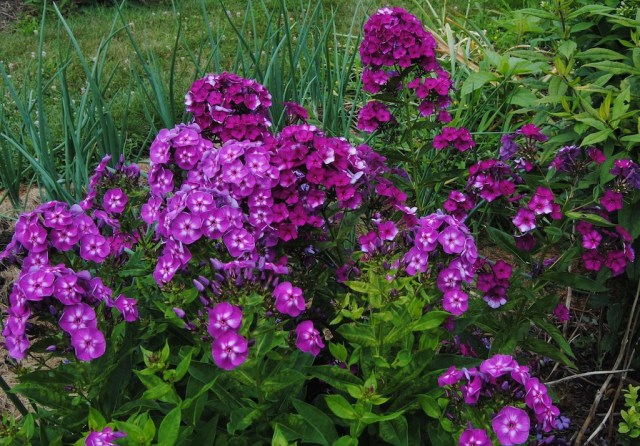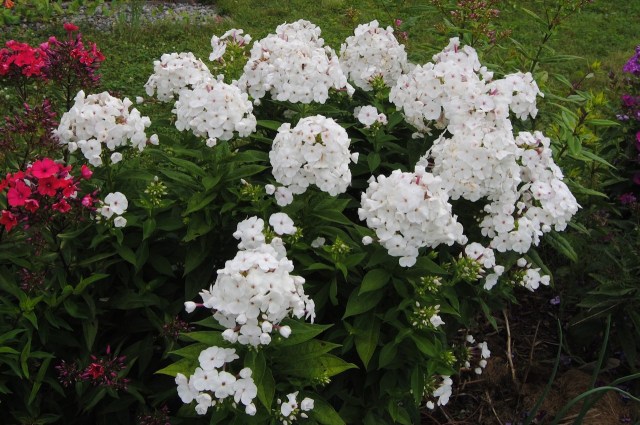I’ll try not to go on too long. Phlox paniculata is one of my favorite flowers and it’s blooming now, and although my garden doesn’t give the best conditions for amazing phlox (rich soil, even moisture, maybe some afternoon shade) it gives me good enough phlox. Phlox (along with snowdrops and cyclamen) have always been among my favorites, and now that I have the room I might as well indulge myself. Here are a couple that are making me happy right now 🙂
I will grow just about any phlox I can get my hands on but should really start to show a little self control…. or not. I love working in the vegetable patch when the breeze has that nice spicy phlox perfume on it. The hummingbirds and butterflies seem to appreciate it too.

This white phlox seedling is one of my favorites, nothing really special, but it’s so reliable. The pink is also a seedling and I like the color but it doesn’t bloom as long as some of the others. I keep it mostly for the odd darker centered leaves… which look slightly diseased when I think on it, but it’s all mine so it’s special.
I know all the books say to deadhead and rip out stray seedlings which sprout since they will overrun your better named phlox, but I’m a little funny about just accepting what people tell me…. plus I’m curious to see if they’ll really all turn out as ugly as the books say (I do still read books btw). Last year this one was a little congested and washed out, I almost tossed it and now I’m glad I didn’t. The cooler weather this summer has brought out some nicer color, and a leaner diet has left it with neater flower heads and I’m again seeing some of the qualities that made me single it out in the first place. I love the height too, it’s close to five feet.

No-name phlox, still nice with it’s white centers and a color that just about matches the verbena bonariensis behind it.
Nearly all my phlox look a little sickly due to a dry spring and summer which really brought on the spider mites. Spraying them off with the water hose and a little fertilizer seems to have discouraged the mites but the damage remains in the form of yellowed and spotty leaves. Strangely enough my variegated ‘Nora Leigh’ has the nicest leaves of all, which surprises me since variegated plants are always supposed to be a little weaker compared to the regular version.

Green grass would be a nicer backdrop for the foliage of ‘Nora Leigh’ but I guess the neighboring fig leaves will have to do.
I’ve been obsessing a bit on the darker colored varieties. ‘Starfire’ is supposed to be especially bright and I think that’s what this is. I don’t know how the mite damaged leaves can support all the bloom it has but they do and I’m glad for it.

‘Starfire’ (maybe?) is definitely bright and probably shouldn’t be right next to white, but it happens. I’m thinking next year it deserves an extra serving of compost for this wonderful performance in the face of adversity.
I’ve been adding new ones here and there. This spring I ordered a nice batch from Perennial Pleasures up in Vermont and was generally pleased with the plants I received. One died a few days after I got it, but I didn’t even bother complaining since I was so happy to have finally found a place which has such an awesome selection of phlox online. Hmmm, I wonder if another order this fall would be too soon 🙂

Phlox ‘blue paradise’ is a new one and it’s of the kind that change their color throughout the day. Cool mornings give a rich blue shade which fades to violet as the day heats up.
My local nursery is pretty good about having a few new phlox each year so they tend to follow me home whenever I make a visit. Here’s ‘Blushing Shortwood’ which joined me last summer… and then spent most of the year sitting in its pot on the driveway. I’m glad to see it hasn’t held this against me.

Phlox ‘blushing shortwood’ with it’s nicely bicolored blooms. The pink seems to fade as the thermometer rises but it’s still a nice flower.
I have a few others but don’t want to overdo it so I’ll stop here. There’s always next year to do it again, and maybe by then I will have turned the entire tropical garden into a phlox field. Now there’s an idea 🙂
Have a great week!








